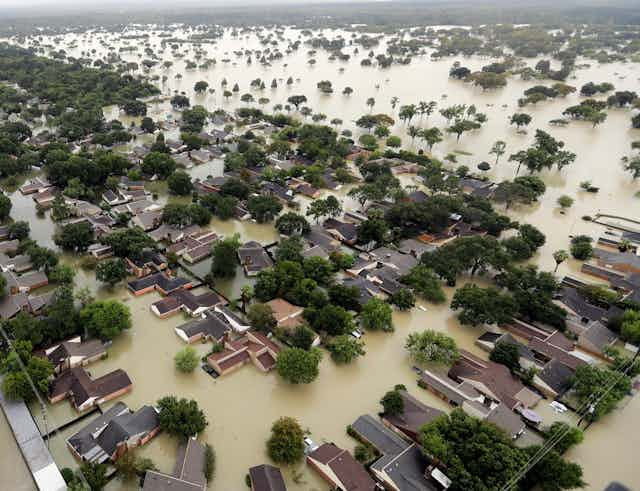The world has witnessed a shocking series of disastrous events in the past several weeks. Devastating hurricanes and Mexico’s 7.1 magnitude earthquake are just some of the latest catastrophes to captivate our collective attention.
Hurricanes, earthquakes and other extreme events aren’t always unexpected, especially given the wealth of knowledge available about Earth’s geophysical system. But the recent rapid succession of them is remarkable even to longtime observers of such events.
What do these recent events mean for the significant changes that have taken place in the insurance and reinsurance sectors to cope with the mounting exposure of private and public actors to disaster risk?
The latest series of disasters represents a serious test to what are known as insurance-linked securities (ILS). They’ve been adopted by insurers, reinsurers — the insurers of insurers — and public entities to limit their exposure to disaster risk and transfer it to financial markets.
The performance of these securities is significant as the U.S. federal government is in the process of integrating ILS into other disaster financing mechanisms within the United States — namely, the National Flood Insurance Program.
Hurricane Andrew and its aftermath
ILS, a relatively recent financial innovation that traces its origins to the mid-1990s, are largely a response by insurers, reinsurers and others being exposed to the increasingly costly impacts of disastrous events.
Effectively, ILS is a way to securitize disaster risk or transfer the exposure of these firms — and, more recently, governments — to the chance that they may have to pay claims in the aftermath of a hurricane, earthquake or other extreme event.
ILS, and their best known variant catastrophe bonds (cat bonds), act both as an insurance policy for those seeking to reduce some of their exposure to disaster risk and an as investment vehicle for those seeking to accept and gain access to that risk by buying into the bonds.
The securitization of storms began in the aftermath of 1992’s Hurricane Andrew and its enormous costs to the state of Florida.

Following the catastrophic damages and the bankruptcies of nine insurers, new financial architecture began to emerge to facilitate new, larger pools of capital being brought into the insurance and reinsurance sector.
This included the establishment of new reinsurance firms in the tax haven of Bermuda, a revolution in using statistical analysis to better model disaster exposure, as well as the creation of state-sponsored public insurers of last resort.
These public entities play an important role in the increasing integration of insurance and financial markets.
They create the underlying asset through the provision of insurance policies to those customers and property owners that private insurers do not want to insure and, later, via ILS and cat bonds, they transfer that risk to financial markets.
Bigger storms, bigger pools
ILS and cat bonds operate on this simple market-based logic: By providing insurers and others seeking to reduce their exposure to disaster risk with larger and more diverse sources of capital, they’ll be better equipped to handle extreme events when they occur.
Proponents of the securitization of storms also argue that by increasing competition between traditional reinsurance firms and new investors seeking to gain access to the market, homeowners and the public more broadly reap benefits by paying less for their insurance policies and enjoying a solvent and secure insurance sector.
These novel financial mechanisms also potentially benefit investors, providing a new source of diversification for their investment portfolio and an attractive yield, especially important in the low interest rate era of the past decade.
For all these reasons, there’s been significant growth of ILS as a source of both insurance and investment.
But larger questions remain unanswered, most importantly how they’ll perform in response to the latest spate of hurricanes and earthquakes.
From a political perspective, the market-based logics of ILS and the growing integration of insurance and finance remain underanalyzed and critiqued.
Crisis and opportunity
Harnessing financial markets to offset disaster risk and exposure for insurers may result in unforeseen or unanticipated results.
There’s currently a great deal of uncertainty about what impact Hurricanes Harvey, Irma, Maria, as well as the recent Mexican earthquakes, will have on ILS and cat bonds.
Regulators set up following the 2008 financial meltdown have warned that insurance-linked securities bear remarkable similarities to mortgage-backed securities (MBS), the financial instrument designed to transfer sub-prime mortgage risk to financial markets that sparked the crisis.
Rather than reducing disaster risk, ILS and cat bonds may actually amplify it by spreading exposure and impacts further than those immediately suffering the disaster’s effects.
While the size of the ILS market and the number of outstanding bonds remain small in comparison to mortgage-backed securities prior to 2008, regulators are concerned that investors may be buying into risk they do not fully understand. That’s a situation eerily close to the one that precipitated the 2008 crisis.
With mortgage-backed securities, sub-prime mortgages posed the risk. With ILS, it’s the exposure of insurers and others to the chance a disaster may strike a particular area during a particular period of time.
The latest series of storms and earthquakes represents a serious test to insurance-linked securities. How they perform will have important consequences for disaster risk management going forward, especially in the era of climate change and the increasing development of disaster-prone areas.

